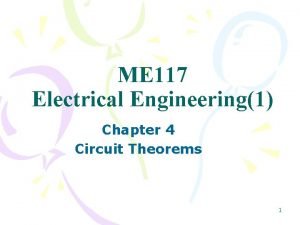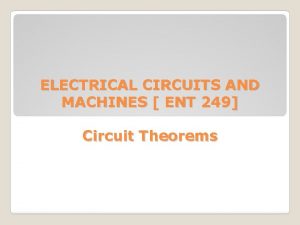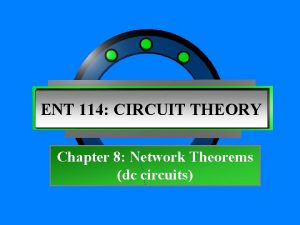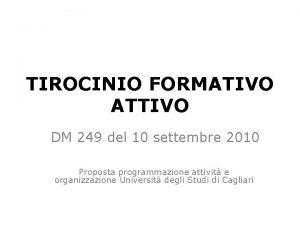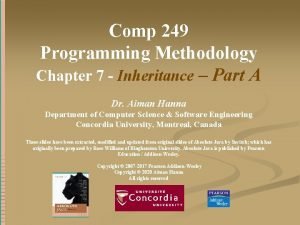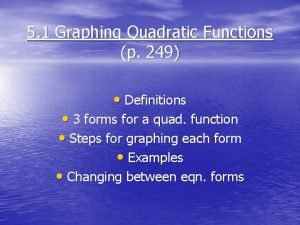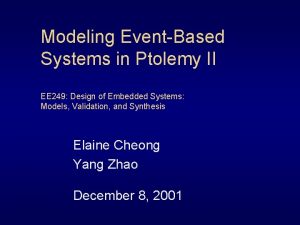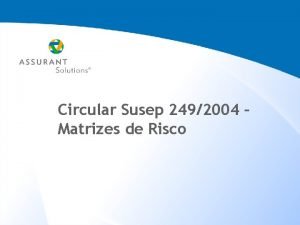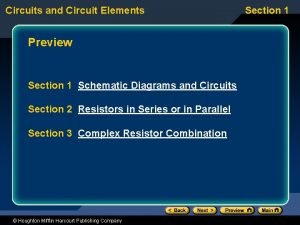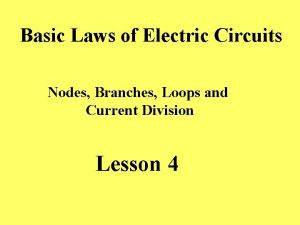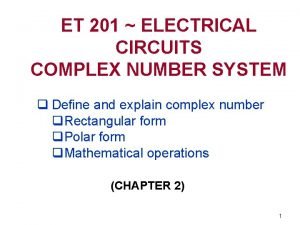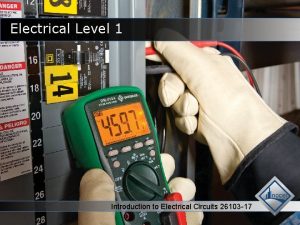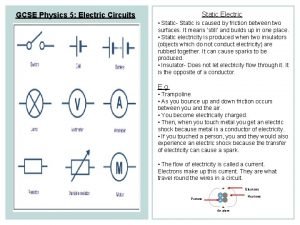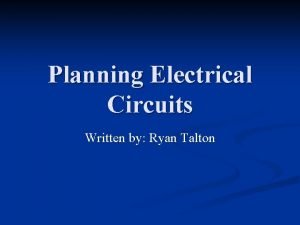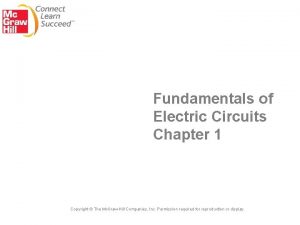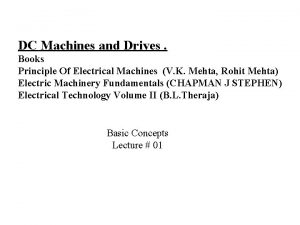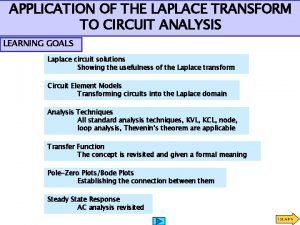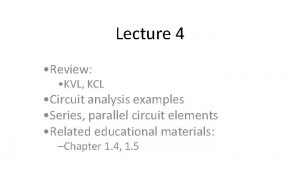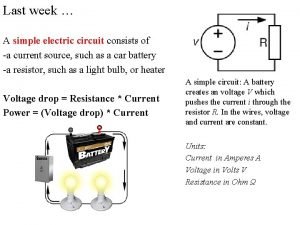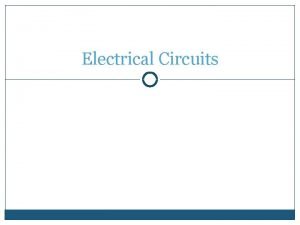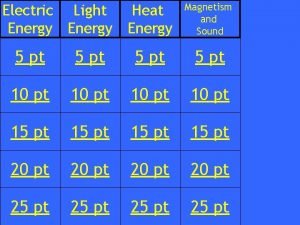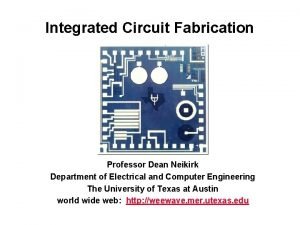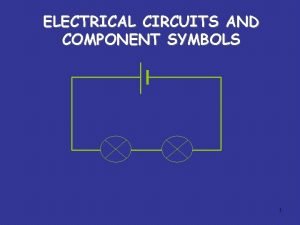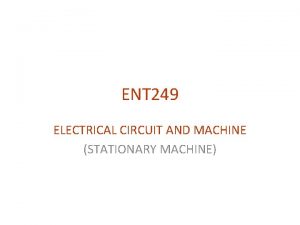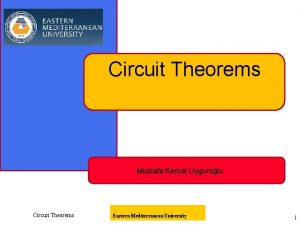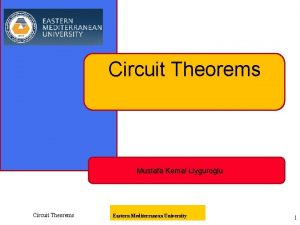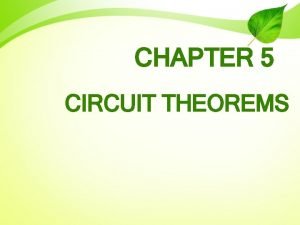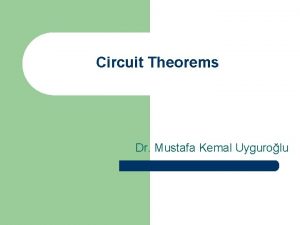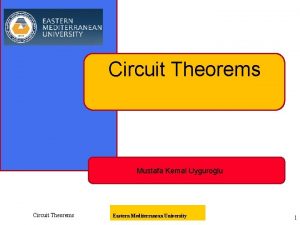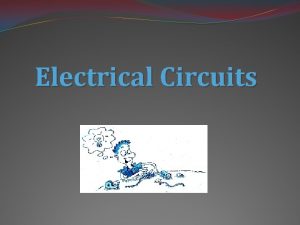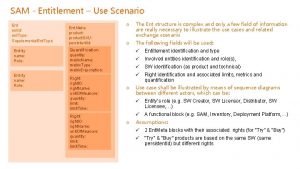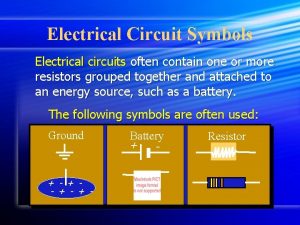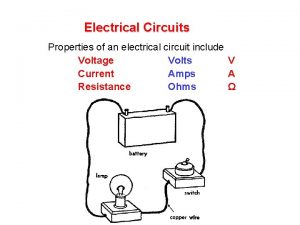ELECTRICAL CIRCUITS AND MACHINES ENT 249 Circuit Theorems
![ELECTRICAL CIRCUITS AND MACHINES [ ENT 249] Circuit Theorems ELECTRICAL CIRCUITS AND MACHINES [ ENT 249] Circuit Theorems](https://slidetodoc.com/presentation_image/435400d85d31237d83e77fa799cee8a1/image-1.jpg)








































- Slides: 41
![ELECTRICAL CIRCUITS AND MACHINES ENT 249 Circuit Theorems ELECTRICAL CIRCUITS AND MACHINES [ ENT 249] Circuit Theorems](https://slidetodoc.com/presentation_image/435400d85d31237d83e77fa799cee8a1/image-1.jpg)
ELECTRICAL CIRCUITS AND MACHINES [ ENT 249] Circuit Theorems

INTRODUCTION �Circuit theorems is apply to analyze the complex circuit. �Function – To simplify the circuit analysis. �Circuit theorems: ØThevenin’s Theorem ØNorthon’s Theorem �Require understanding of the concept of Superposition, Source Transformation, Maximum Power Transfer before go through theorem.

CONTENTS �Introduction �Superposition Theorem �Source Transformation �Thevenin’s Theorem �Northon’s Theorem �Maximum Power Transfer

SUPERPOSITION 1. Use to determine the value of a specific variable (voltage or current); based on linearity. The superposition principle states that the voltage across (or current through )an element in a linear circuit is the algebraic sum of the voltage across ( or current through) that element due to each independent source acting alone. 1. Steps to apply superposition principle: a) Turn off all independent sources except one source. Find the output (voltage or current ) due to that active source using previous techniques. b) Repeat step(a) for each of the other independent sources. c) Find the total contribution by adding algebraically all the contributions due to the independent sources. Disadvantage – may involve more work.

SUPERPOSITION Keep in mind: • To consider only one independent source, every voltage sources are replaced by 0 V (short circuit) and current sources by 0 A (open circuit). • Dependent sources are left intact because they are controlled by circuit variables.

SUPERPOSITION Example: Use the superposition theorem to find v in the circuit in Figure shown. Solution

SUPERPOSITION

SUPERPOSITION Example: For the circuit shown, use the superposition theorem to find i. Turn off Solution: Turn off Figure 4. 13 (a)

SUPERPOSITION Turn off Figure 4. 13 (b) Turn off

SUPERPOSITION Turn off Figure 4. 13 (c)

SOURCE TRANSFORMATION • Source transformation is another tool for simplifying circuits (like series-parallel and wye – delta ). A source transformation is the process of replacing a voltage source vs in series with a resistor R by a current source is in parallel with a resistor R, or vice verse. • Basic to these tools is the concept of equivalence.

SOURCE TRANSFORMATION • Source transformation also applies to dependent source. Note: 1. The arrow of the current source is directed toward the positive terminal of the voltage source. 2. Source transformation is not possible when R=0 (ideal voltage source) and R=∞ (ideal current source)

SOURCE TRANSFORMATION Example: Use source transformation to find vo in the circuit given. Solution: 1. Transform the current and voltage sources.

SOURCE TRANSFORMATION 2. Combine the 4Ω and 2Ω resistors in series and transform the 12 V voltage source. 3. Combine the 2 -A and 4 -A current sources to get 2 -A source. Combine the 6Ω and 3Ω resistors in parallel to get 2Ω. 4. Use current division to get i.

THEVENIN’S THEOREM • Usage: to avoid analyzing entire circuit for every changes in variable element. • Provides a technique by which the fixed part of the circuit is replaced by an equivalent circuit. Thevenin’s theorem states that a linear two – terminal circuit can be replaced by an equivalent circuit consisting of a voltage source VTH in series with a resistor RTH, where VTH is the open circuit voltage at the terminals and RTH is the input or equivalent resistance at the terminals when the independent sources are turned off.

THEVENIN’S THEOREM Let’s consider the figure: • We would like to replace the original linear two-terminal circuit by its equivalent Thevenin circuit. • The circuits are said to be equivalent if they have same voltage-current relation at their terminals. • If the terminals a-b are made open-circuited (by removing the load), no current will flows, so that the terminals a-b must be equal to the voltage source VTH , since the two circuits are equivalent, Therefore:

THEVENIN’S THEOREM • With the load disconnected and terminals a-b open-circuited, we turn off all independent sources. • The input resistance of the dead circuit at the terminals a-b must be equal to RTH since the two circuits are equivalent,

THEVENIN’S THEOREM Finding VTh and RTh In finding the Thevenin resistance RTh, we need to consider two cases: Case 1: If the network has no dependent sources, we turn off all independent sources. RTh is the input resistance of the network looking between terminals a and b.

THEVENIN’S THEOREM Case 2: If the network has dependent sources, we turn off all independent sources. We apply a voltage source vo at the terminals a and b determine the resulting current io. Then RTh= vo/io as shown below. Alternatively, we may insert a current source io at terminals a-b and find the terminal voltage vo. Again RTh= vo/io (either of the two approaches will give the same result. )

THEVENIN’S THEOREM • Important of Thevenin’s theorem- helps simplify a circuit (a large circuit may be replaced by a single independent voltage source and a single resistor) • The current IL through the load and the voltage VL across the load are easily determined once the Thevenin equivalent of the circuit at the load’s terminals is obtained Note: A negative RTh value shows that the circuit is supplying power (circuit with dependent source)

THEVENIN’S THEOREM

THEVENIN’S THEOREM Example: Find the Thevenin equivalent circuit shown in Figure below, to the left of the terminals a-b. Then find the current through RL=6, 16, and 36Ω. Solution:

THEVENIN’S THEOREM

THEVENIN’S THEOREM

THEVENIN’S THEOREM Exercise: Using Thevenin’s theorem, find the equivalent circuit to the left of the terminals in the circuit shown. Then find I. Hints: 1) Find RTH by turning off voltage & current source 2) Find VTH by using source transformation (voltage divider) 3) Finally, find i and draw Thevenin equivalent circuit

THEVENIN’S THEOREM (dependent source) Example: Find the Thevenin equivalent circuit shown in Figure below.

THEVENIN’S THEOREM

NORTHON’S THEOREM Norton’s theorem states that a linear two-terminal circuit can be replaced by an equivalent circuit consisting of a current source IN in parallel with a resistor RN where IN is the short circuit current between two output terminals in the circuit and RN is the total equivalent resistance at the terminals when the independent sources are turned off. We find RN in the same way we find RTh Simplified to this

NORTHON’S THEOREM To find IN: • Determine the short-circuit current flowing from terminal a to b in both circuits. • Since the two circuits are equivalent, From Thevenin equivalent, use Source transformation to determine IN

NORTHON’S THEOREM To determine the Thevenin or Northon equivalent circuit, we must find: • The open – circuit voltage vc across terminals a and b, since Vth=voc. • The short – circuit current Isc at terminals a and b , since IN=ISC • The equivalent or input resistance Rin at terminals a and b when all independent sources are turned off, yields:

NORTHON’S THEOREM Example: Find the Northon equivalent of the circuit at terminal a-b. Solution:

NORTHON’S THEOREM

NORTHON’S THEOREM

NORTHON’S THEOREM Exercise: Find the Northon equivalent circuit for the circuit shown.

THEVENIN & NORTHON’S THEOREM Thevenin’s theorem states that a linear two – terminal circuit can be replaced by an equivalent circuit consisting of a voltage source VTH in series with a resistor RTH, where VTH is the open circuit voltage at the terminals and RTH is the input or equivalent resistance at the terminals when the independent sources are turned off. Simplified to this Norton’s theorem states that a linear two-terminal circuit can be replaced by an equivalent circuit consisting of a current source IN in parallel with a resistor RN where IN is the short circuit current between two output terminals in the circuit and RN is the total equivalent resistance at the terminals when the independent sources are turned off.

MAXIMUM POWER TRANSFER • Practically, a circuit is designed to provide power to a load. • Certain application, e. g. , communication – desirable to maximize the power delivered to a load. • Thevenin equivalent is useful in finding the maximum power a linear circuit can deliver to a load. • By assuming that the load resistance, RL can be adjusted, the power delivered to the load is: Where VTh and RTh are fixed

MAXIMUM POWER TRANSFER • Relationship of power and load resistance: By varying the load resistance RL, the power delivered to the load varies as sketched in Figure 4. 49. Load receive maximum power from network when its resistance is exactly equal to the Thevenin Resistance of the network applied to the load. maximum power occurs when RL=RTh.

MAXIMUM POWER TRANSFER • Maximum power theorem stated that the maximum power is transferred to the load when the load resistance equals the Thevenin resistance as seen from the load (RL=RTh) • Therefore when RL=RTh, maximum power is equal to:

MAXIMUM POWER TRANSFER Example: Find the value of RL for maximum power transfer in the circuit shown. Find the maximum power. Solution:

MAXIMUM POWER TRANSFER

FURTHER READING 1. Fundamentals of Electric Circuits, 6 th Edition, Mc. Grawhill Alexander, C. K. and Sadiku, M. N. O. 2. Electric Circuit, 8 th Edition, Pearson, Nillson and Riedel. 3. Circuits, Brooks/ Cole, A. Bruce Carlson. 4. http: //www. scribd. com/word/full/2031941? access_key=key 1 vybbz 6 deqeinoosecmm
 Electrical theorems
Electrical theorems Northon
Northon Advantages of parallel circuits over series circuits
Advantages of parallel circuits over series circuits Voltage devider rule
Voltage devider rule Dc circuit theorems
Dc circuit theorems Lesson 5: electrical nonmetallic tubing (ent)
Lesson 5: electrical nonmetallic tubing (ent) Dm 249 2010
Dm 249 2010 Artigo 249 cc
Artigo 249 cc Resit kew 38
Resit kew 38 Comp 249
Comp 249 (-5 1) graph
(-5 1) graph Ee 249
Ee 249 Ee 249
Ee 249 Circular susep 249
Circular susep 249 Circuits and circuit elements
Circuits and circuit elements Different types of circuits
Different types of circuits Node branch loop formula
Node branch loop formula Et 201
Et 201 Nccer introduction to electrical circuits
Nccer introduction to electrical circuits Electrical circuits gcse
Electrical circuits gcse Planning electrical circuits
Planning electrical circuits A circuit is
A circuit is Magnetic materials used in electrical machines
Magnetic materials used in electrical machines Principles of electrical machines vk mehta
Principles of electrical machines vk mehta Principle of operation of synchronous motor
Principle of operation of synchronous motor Fusao
Fusao Complete circuit and incomplete circuit
Complete circuit and incomplete circuit Reflection and refraction venn diagram
Reflection and refraction venn diagram Pulmonary circuit and systemic circuit
Pulmonary circuit and systemic circuit Politeknik kota bharu
Politeknik kota bharu E l n plug
E l n plug Laplace transform for circuit analysis
Laplace transform for circuit analysis Kvl kcl examples
Kvl kcl examples Circuit symbols
Circuit symbols What is an electrical load
What is an electrical load Flashlight electrical circuit
Flashlight electrical circuit Electrical circuit
Electrical circuit Electric circuit analysis using laplace transform
Electric circuit analysis using laplace transform What are the three elements of electricity
What are the three elements of electricity Dean neikirk
Dean neikirk Electrical circuit analogy bakery
Electrical circuit analogy bakery Parts of electrical circuit
Parts of electrical circuit
